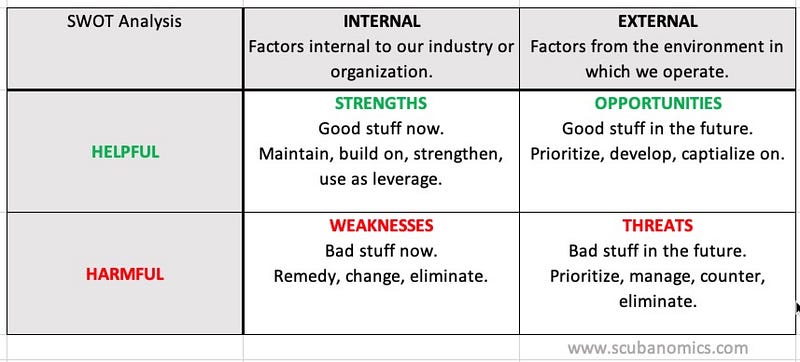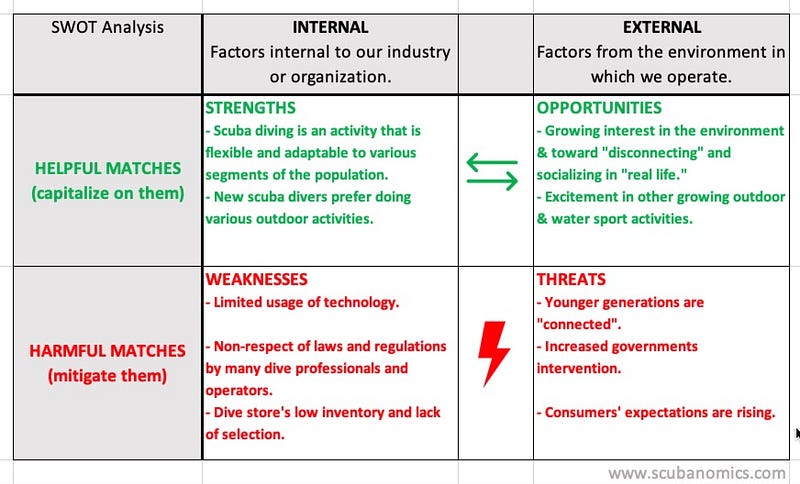SWOT Analysis of The Scuba Diving Industry
Strengths, Weaknesses, Opportunities & Threats in Today’s Scuba Diving Markets
A SWOT analysis is one of the oldest methods to study a business — or a project, a career, or anything you want. Initially, the goal of a SWOT analysis was to identify why corporate planning failed. Nowadays, we use it more proactively.
In this post, we look at the scuba diving industry as a whole and, when appropriate, at specific dive industry stakeholders. But, first, let’s clarify what a dive industry SWOT analysis is.
AN ANALYST’S WORK IS NEVER DONE: Internal and external factors impacting our dive businesses and scuba diving industry frequently change, and we need to update our analysis. Since dive industry analyses lead to dive industry strategies, we also need to regularly review our strategies to ensure they remain valid.
This post is part of our Shifting Tides: Dive Industry Assessment & Strategies for Today’s Scuba Divers series by the Business of Diving Institute and Darcy Kieran, author of:
Table of Contents
What is a Dive Industry SWOT Analysis?
The main goal of a SWOT Analysis is to prepare ourselves for problems (better be ready than sorry) and reveal opportunities to pursue. The PESTLE framework is an excellent tool to identify external threats and opportunities. Perform a PESTLE analysis before a SWOT analysis.
SWOT is an acronym that stands for:
- Strengths
- Weaknesses
- Opportunities
- Threats
Strengths & Weaknesses are internal to the dive industry. They are within our control. Strengths are positive attributes on which we can build our industry. Meanwhile, weaknesses detract from our ability to achieve our goals.
Opportunities & Threats are external to the dive industry. They are beyond our control but have an impact on us. Threats put the sector at risk. We should have contingency plans to address them. Alternatively, we can develop strategies to survive these threats — like a sailor finds ways to deal with an upcoming storm. Meanwhile, opportunities are factors giving us a chance to pursue the development of the dive industry.
Threats and opportunities can already be present in our business environment or expected to happen in the future. Before drawing up plans and strategies, we need to assess the probability of these threats and opportunities happening, and how critical they would be to the industry if they were to materialize.
In our case, in this post, we will list a limited number of key strengths, weaknesses, opportunities, and threats.
SWOT is usually represented in a 2×2 table as follows:

When performing a SWOT Analysis, you start with a blank sheet. Since you don’t want to list a million factors in each square, you rely on your experience to determine the factors worth noting and working on. It means that two different people are likely to produce different SWOT analyses. Generally, though, common themes emerge.
What To Do With The Results of a Dive Industry SWOT Analysis
There’s no point in producing a SWOT analysis just to put it on a shelf and let it collect dust. You might as well send it to the recycling bin right away or better yet, not do it.
You want to use the results of the SWOT analysis to make decisions and actions.
But what should we tackle first? It depends on our goals and how crucial each factor is. For instance, there’s no point chasing an opportunity if the skills and resources required to benefit from it are an area of weakness for us. And there’s no point losing sleep over a threat that would have minimal impact on our business.
Usually, to remain or grow strong, we have 2 top priorities:
- Identifying matches between our internal strengths and external opportunities to capitalize on them.
- Identifying matches between our internal weaknesses and external threats to mitigate them. These are bullets coming our way. We need to fix our vulnerabilities or find ways to get out of the path of the bullets.
Therefore, I much prefer the following representation of a SWOT analysis grid:

- Green: Any match between our internal strengths and external opportunities should represent a low-hanging fruit to harvest.
- Red: Any match between our internal weaknesses and external threats represents a bullet to dodge.
Beyond working on these good and evil “matches,” we want to look at each quadrant, individually, before drafting business strategies.
Here’s what you want to do with the factors identified in each quadrant:

- Strengths: Internal factors that are good, for now. Maintain them, build on them, strengthen them, and use them as leverage.
- Weaknesses: Internal factors that are bad at the moment. Remedy, change, or eliminate them.
- Opportunities: External factors that are good, either right now or in the future. Prioritize them, develop strengths to support taking advantage of them, and capitalize on them.
- Threats: External factors that are bad, either right now or in the future. Prioritize them, manage them, counter them, and work on eliminating any weakness that would make the threat even more dangerous.
In short, you want your Dive Industry SWOT Analysis to be “USED”:
- Use your strengths
- Stop your weaknesses
- Exploit opportunities
- Defend against threats
Now, let’s dive into a scuba diving SWOT analysis. We only list factors we believe to be most important for the dive industry, at this point.
This is a work in progress. The Dive Industry SWOT Analysis will never be fully completed. We’ll continue to fine-tune factors identified as strengths, weaknesses, opportunities, and threats.
Scuba Diving Industry Strengths
General Strengths
Scuba diving is an activity that is flexible and adaptable for various segments of the population:
- It can be extreme or easy.
- It can be for all ages.
- A full family can do it.
- It can be about discovering the underwater world or a personal challenge.
Scuba diving is well-known in the population. When you mention “scuba diving,” people know what it is. Awareness is high, which is Step 1 of marketing efforts.
- It’s often visible in movies.
- It’s regularly part of ads for many holiday and honeymoon vacation destinations.
Scuba diving is still wanted by the baby boomer generation.
Dive Centers / Schools / Independent Instructors Strengths
- Passionate people.
- Connected in their local communities and with local dive clubs.
- Know the local dive sites.
Training Agencies Strengths
- Well-established training programs (for most of them).
- Some international brand recognition.
- In a position of strength vs. its clients (see Porter’s 5 Forces analysis of the dive industry).
Dive Manufacturers Strengths
- Brands & lines of products established over time.
- In a position of strength vs. its clients (see Porter’s 5 Forces analysis of the dive industry).
Scuba Diving Industry Weaknesses
General Weaknesses
Customer expectations are different at a retail store (dive gear) and a school (dive courses). Both are sold under one roof under the traditional definition of a dive center forced upon us by training agencies and dive manufacturers.
Incoherent image: too extreme or too dull. This is the flip side of scuba diving being highly adaptable to different interests and aspirations. It can be a strength. However, it becomes a weakness when you try to market your products - the identity is not clear.
- Is scuba diving a one-time adventure to check off your bucket list? Or a lifestyle? Or a fun activity to do once in a while?
- Is scuba diving like yoga underwater? Or like risking your life with sharks and cave diving?
- Is scuba diving merely a tool to perform an activity underwater (like binoculars are to the bird watcher)?
Unreliable. There is no consistency in the quality of the experience under any brand in the dive industry.
- Quality of experience varies from ‘great’ to ‘life-threatening’ from one dive location to the next. And even, from one day to the next, at the same place.
- Many people running away after a lousy scuba tryout experience.
Perception of ‘expensive & complicated.’
High drop-out rate.
Limited usage of technology.
Non-respect of laws and regulations by many dive professionals, including consumer protection laws, health & safety rules, and workers compensation regulations.
Dive Shops Weaknesses
- Dive businesses are mainly owned by hobbyists, not business people. Lacking management skills.
- Usually undercapitalized, living from month to month.
- Most dive shops are Mom & Pop operations lacking financing and human resources.
- No consistency in service between dive shops displaying the same dive training agency brand. Regularly no consistency in service from one day to the next, from one staff member to the next.
- Lack of sales and customer service training for in-store staff.
- High staff turnover.
- “Nothing in stock” (low inventory; lack of selection).
- Dive gear remains the primary source of profits, but it is now readily available online (for purchasing & for info) in all sizes, colors, and models.
- Still heavily relying on gear sales to cover the costs of operating the other five business units. Yet, gear sales volume is down, and profitability on gear sales is also down.
- In a position of weakness vs. its two biggest suppliers: Training agencies & dive gear manufacturers (see Porter’s 5 Forces analysis).
- Little or no budget for sales & marketing.
- “6 businesses in one” means that none of them are well managed (or only one is well managed). Different skillsets for each one.
- Very little product differentiation leading to clients shopping for price (for gear and courses).
Independent Instructors & Dive Schools Weaknesses
- No promotional network. They are invisible on training agencies’ websites.
- Their product is scuba courses, which is the industry loss leader.
- Lots of legal & moral responsibilities for little pay, leading to the short lifespan of the career.
Dive Resorts Weaknesses
- Few repeat customers who like to visit new dive destinations. Must consistently “recruit” new dive-clients.
- Can market around the world, competing against all other dive resorts in the world. Need a large marketing budget.
- Competing on price, commissions, comps.
- More dependent on weather, environment, and airlines than other dive industry stakeholders.
Training Agencies Weaknesses
- Relying on dive shops to represent their brand and sell their products to clients. And dive shops are the weakest link in the chain.
Dive Manufacturers / Gear Brands Weaknesses
- Relying on dive shops to represent their brand and sell their products to clients. And dive shops are the weakest link in the chain.
- No dive shop carries your entire line of products.
- Brands are not much known outside scuba diving, unlike a Body Glove in surfing, for instance.
- Lack of new product design. Many products are almost identical between brands and come from the same Asian manufacturer.
- Wholesaler more than a manufacturer, for many of your products.
Scuba Diving Industry Opportunities
- A growing need for unique pictures & videos to post on social media.
- Growing concerns and interest in the environment.
- Growing interest toward “disconnecting” and socializing in “real life.”
- The excitement in other growing outdoor & water sport activities. Could we cross-promote? Copy? Benefit?
- Government support, like the ski industry in Colorado.
- For Dive Resorts: more online theory leads to more courses in dive destinations, less in origin centers.
The lack of consistency in the quality of the experience should also be seen as an opportunity. The first player to address and fix this issue will have a significant first-mover advantage.
Scuba Diving Industry Threats
General Threats
- Fewer new diver certifications. Shrinking participation rate.
- High drop-out rate.
- Lower interest from the younger generations.
- Younger generations want to “do” scuba diving, among other activities (casual diver), not “be” a diver (core diver).
- Fewer gear sales per diver trained.
- Airlines are making it more challenging to travel with your dive gear. Limitations on luggage & carry-ons.
- Deteriorating environment and dive sites.
- Uncertainties around insurance.
- Increased government intervention.
Threats to Dive Shops
- Direct-to-consumer sales from training agencies and dive gear brands.
- More difficult for staff to “sell what we have” because the customer comes to the dive shop after shopping online. They are informed from other sources.
- Dive gear available in outdoor stores and big surface stores, like West Marine and Decathlon.
- More online theory leads to more courses in dive destinations, less in local dive shops (origin dive centers).
Threats to Dive Resorts
- Interest shifting toward multi-activities vacation destinations, not ‘dive’ resorts.
- Websites specialized in dive travel bookings, taking an additional percentage off your top line, and making a commodity of your product offering.
Threats to Training Agencies
- High prices are more difficult to justify with online course material and video than it was with printed material.
Treats to Dive Manufacturers / Gear Brands
- Becoming easier for retailers to buy directly from the original suppliers, bypassing the established dive gear brands.
“Matches” in Our Dive Industry SWOT Analysis
Now that we have identified key strengths, weaknesses, opportunities, and threats in the dive industry, we want to:
- Identify matches between our internal strengths and external opportunities to capitalize on them. All opportunities are worth exploring. However, an opportunity matching one of our strengths may be easier to capitalize on.
- Identify matches between our internal weaknesses and external threats to mitigate them. We need to evaluate the risk of each threat to our business. However, a threat matching one of our weaknesses is a top priority.

What’s Next?
Once we’ve completed our preliminary analysis of the scuba diving industry, we will summarize key trends and initial strategic analysis takeaways before moving on to the next section where we’ll work on brainstorming strategies for the scuba diving industry.
Porter’s Five Forces provide us with a snapshot of the current competitive forces in the dive industry. It helps predict profitability. A SWOT Analysis helps us identify if any of our weaknesses should be fixed to prevent going head-to-head with one of the external threats and what opportunities match our strengths. The 4Ps and the 4Cs are focused on the marketing of our scuba diving products and services. Meanwhile, the PESTLE Analysis looks into the external macro-environmental factors impacting our industry. It is a tool to identify threats and weaknesses for the SWOT analysis.
Continue reading about Shifting Tides: Dive Industry Assessment & Strategies for Today’s Scuba Divers.
If you found the information on this page valuable, would you consider buying me a coffee?
Either way, let’s work together on “raising the bar” in the dive industry to satisfy today’s consumers!
Your Dive Industry Compass
Scuba Diving Market Research, Surveys, Reports & Statistics
Shifting Tides
Strategies for Today’s Scuba Divers
Living The Scuba Dream
Plan Your Scuba Instructor Career & Deep Dive the Plan
You may also be interested in The Immersion Zone (our podcast), Scubanomics (our newsletter for dive professionals), and our published books & reference guides.





